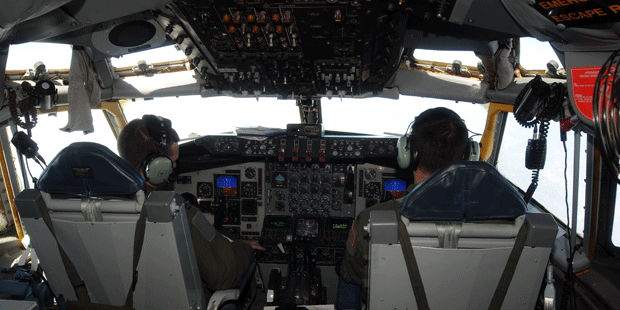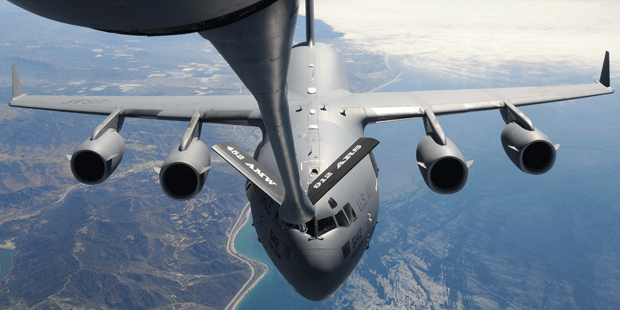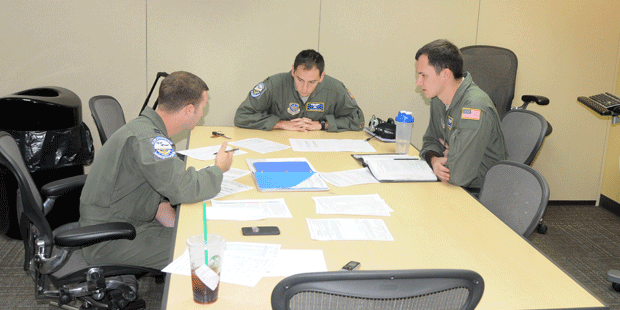When most people read about military units, the limelight is typically thrown upon the warrior types. In the United States Air Force, the stories normally fall on the fighter pilots and bomber crews, or the adventure types such as test pilots and astronauts.
I have recently turned my attention to the support units — the people behind the warriors, whom if they did not do their job, the warrior types could not do theirs. This article centers on tanker crews.
The unofficial motto of these tanker crews is classic — “Nobody kicks ass, without Tanker gas.” So true, as their job is to refuel other U.S. military and allied planes during long range missions around the world, all while staying airborne.
I called upon the Public Affairs Superintendent at March Air Reserve Base, Mrs. Linda Welz. She holds the same position when she is in the uniform of a U.S. Air Force Master Sergeant when she is performing her duties as reservist. Again, a position that does not get a lot of up front respect. If it weren’t for our citizen-soldiers, the United States military would be hard pressed to maintain its military readiness around the world. It is a rough estimate that 75% of all U.S. Air Force Reserve pilots are also the same pilots who are flying your commercial airlines. Many of the reservists are police officers, firefighters, medical doctors, and any other occupation you may think of. They put on their uniforms every month and when called upon to serve our country.
March Air Reserve Base in Southern California’s Riverside County was first established in February of 1918, making it one of the oldest airfields operated by the military.
The base was first established as the Alessandro Flying Training Field before its named was changed to Marine Air Force Base. Due to major budget cuts, the base was transformed into a Reserve base in March of 1993.
It is home to the Air Force Reserve Command’s 4th Air Force Headquarters and the host of the 452nd Air Mobility Wing (452 AMW), the largest air mobility wing of the 4th Air Force.
I met with Colonel Russell A. Muncy, Commanding Officer of the 452nd Air Mobility Wing. (The wing is the Air Force Reserve’s largest and only unit-equipped air mobility wing, with nine C-17As, 14 KC-135Rs and some 4,000 reservists.) He gave a quick briefing of the unit’s mission and history. Many famous members of the U.S. Air Force have served at this base including Jimmy Dolittle, Hap Arnold and Curtis LeMay. The very first USO/Bob Hope show took place here in May of 1941.
Soon after, I was flying with pilot Captain Josh Welch of Titusville, Florida; Cc-pilot 1st Lt. Jon Flanagan, of Everett, Washington; and boom operator Staff Sergeant Matt Nelson, from Chisago City, Minnesota. We were aboard Boeing KC-135R named “Wild Thang.”
I was allowed to sit in the jump seat on the flight deck. As we took off, I could see the Boeing C-17 Globemaster III that would be accompanying us on this training mission. Our mission would first take us south where the observatory on Mt. Palomar could be seen. It was a clear and sunny day with little wind. We turned west and headed for the coast. After passing over coastal, I could suddenly see San Clemente Island to the south. San Clemente Island is the southern most in California’s Channel Islands, and is owned by the United States Navy. We soon passed over Catalina Island and were joined by the C-17, trailing behind us. We stayed at approx 28,000 ft. and started to lower the boom (the device which passes fuel to the other plane by connecting a pipe into the other planes gas tank).
As we came back over the coastline, we continued north following the coastline up California’s famous Hwy 1, and on our way towards San Francisco, CA. The C-17, while not receiving any fuel on this mission, but would come in below the KC-135 and connect repeatedly with the boom as if it were receiving gasoline in real life. This training continued for almost 45 minutes before the training period ended and we headed south back towards March ARB.
I asked Staff Sergeant Nelson about his training. After his initial boot camp training, he was sent to the Boom Operators School for training, an 8- to 12-month stint. He then went to SERE school at Fairchild AFB in Washington. SERE is the Survival, Evasion, Resistance, and Escape. He had all of this training before being assigned to his unit.
Story and photos by Doug Aguillard
When most people read about military units, the limelight is typically thrown upon the warrior types. In the United States Air Force, the stories normally fall on the fighter pilots and bomber crews, or the adventure types such as test pilots and astronauts.
I have recently turned my attention to the support units — the people behind the warriors, whom if they did not do their job, the warrior types could not do theirs. This article centers on tanker crews.
The unofficial motto of these tanker crews is classic — “Nobody kicks ass, without Tanker gas.” So true, as their job is to refuel other U.S. military and allied planes during long range missions around the world, all while staying airborne.
I called upon the Public Affairs Superintendent at March Air Reserve Base, Mrs. Linda Welz. She holds the same position when she is in the uniform of a U.S. Air Force Master Sergeant when she is performing her duties as reservist. Again, a position that does not get a lot of up front respect. If it weren’t for our citizen-soldiers, the United States military would be hard pressed to maintain its military readiness around the world. It is a rough estimate that 75% of all U.S. Air Force Reserve pilots are also the same pilots who are flying your commercial airlines. Many of the reservists are police officers, firefighters, medical doctors, and any other occupation you may think of. They put on their uniforms every month and when called upon to serve our country.
March Air Reserve Base in Southern California’s Riverside County was first established in February of 1918, making it one of the oldest airfields operated by the military.
The base was first established as the Alessandro Flying Training Field before its named was changed to Marine Air Force Base. Due to major budget cuts, the base was transformed into a Reserve base in March of 1993.
It is home to the Air Force Reserve Command’s 4th Air Force Headquarters and the host of the 452nd Air Mobility Wing (452 AMW), the largest air mobility wing of the 4th Air Force.
I met with Colonel Russell A. Muncy, Commanding Officer of the 452nd Air Mobility Wing. (The wing is the Air Force Reserve’s largest and only unit-equipped air mobility wing, with nine C-17As, 14 KC-135Rs and some 4,000 reservists.) He gave a quick briefing of the unit’s mission and history. Many famous members of the U.S. Air Force have served at this base including Jimmy Dolittle, Hap Arnold and Curtis LeMay. The very first USO/Bob Hope show took place here in May of 1941.
Soon after, I was flying with pilot Captain Josh Welch of Titusville, Florida; Cc-pilot 1st Lt. Jon Flanagan, of Everett, Washington; and boom operator Staff Sergeant Matt Nelson, from Chisago City, Minnesota. We were aboard Boeing KC-135R named “Wild Thang.”
I was allowed to sit in the jump seat on the flight deck. As we took off, I could see the Boeing C-17 Globemaster III that would be accompanying us on this training mission. Our mission would first take us south where the observatory on Mt. Palomar could be seen. It was a clear and sunny day with little wind. We turned west and headed for the coast. After passing over coastal, I could suddenly see San Clemente Island to the south. San Clemente Island is the southern most in California’s Channel Islands, and is owned by the United States Navy. We soon passed over Catalina Island and were joined by the C-17, trailing behind us. We stayed at approx 28,000 ft. and started to lower the boom (the device which passes fuel to the other plane by connecting a pipe into the other planes gas tank).
As we came back over the coastline, we continued north following the coastline up California’s famous Hwy 1, and on our way towards San Francisco, CA. The C-17, while not receiving any fuel on this mission, but would come in below the KC-135 and connect repeatedly with the boom as if it were receiving gasoline in real life. This training continued for almost 45 minutes before the training period ended and we headed south back towards March ARB.
I asked Staff Sergeant Nelson about his training. After his initial boot camp training, he was sent to the Boom Operators School for training, an 8- to 12-month stint. He then went to SERE school at Fairchild AFB in Washington. SERE is the Survival, Evasion, Resistance, and Escape. He had all of this training before being assigned to his unit.
After several hours in flight we landed back at March ARB safely and as always thankful for these men and women who volunteer to serve and protect our country. I want to thank Colonel Muncy, Master Sergeant Weiz, the crew of the Wild Thang, Captain Wilke, 1st Lt. Flannigan, and Staff Sergeant Nelson and of course the United States Air Force Reserve for making this opportunity a wonderful experience.
After several hours in flight we landed back at March ARB safely and as always thankful for these men and women who volunteer to serve and protect our country. I want to thank Colonel Muncy, Master Sergeant Weiz, the crew of the Wild Thang, Captain Wilke, 1st Lt. Flannigan, and Staff Sergeant Nelson and of course the United States Air Force Reserve for making this opportunity a wonderful experience.




